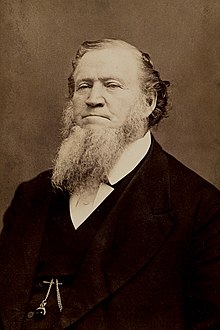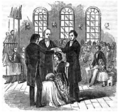Portal:Latter Day Saint movement
|
Welcome to the portal of The Latter Day Saint movement
Introduction The Latter Day Saint movement (also called the LDS movement, LDS restorationist movement, or Smith–Rigdon movement) is the collection of independent church groups that trace their origins to a Christian Restorationist movement founded by Joseph Smith in the late 1820s. Collectively, these churches have over 17 million nominal members, including over 17 million belonging to the Church of Jesus Christ of Latter-day Saints (LDS Church), 250,000 in Community of Christ, and several other denominations with memberships generally ranging in the thousands of members. The predominant theology of the churches in the movement is Mormonism, which sees itself as restoring again on Earth the early Christian church; their members are most commonly known as Mormons. An additional doctrine of the church allows for prophets to receive and publish modern-day revelations. A minority of Latter Day Saint adherents, such as members of Community of Christ, have been influenced by Protestant theologies while maintaining certain distinctive beliefs and practices including continuing revelation, an open canon of scripture and building temples. Other groups include the Remnant Church of Jesus Christ of Latter Day Saints, which supports lineal succession of leadership from Smith's descendants, and the more controversial Fundamentalist Church of Jesus Christ of Latter-Day Saints, which defends the practice of polygamy. (Full article...) General images -The following are images from various Latter Day Saint movement-related articles on Wikipedia.
Selected articleJames Jesse Strang (March 21, 1813 – July 9, 1856) was an American religious leader, politician and self-proclaimed monarch. He served as a member of the Michigan House of Representatives from 1853 until his assassination. In 1844, he said he had been appointed as the successor of Joseph Smith as leader of the Church of Jesus Christ of Latter Day Saints (Strangite), a faction of the Latter Day Saint movement. Strang testified that he had possession of a letter from Smith naming him as his successor, and furthermore reported that he had been ordained to the prophetic office by an angel. His followers believe his organization to be the sole legitimate continuation of the Church of Christ founded by Smith fourteen years before. (Full article...) Selected location The Yearning for Zion Ranch, or the YFZ Ranch, was a 1,700-acre (690-hectare) Fundamentalist Church of Jesus Christ of Latter-Day Saints (FLDS) community of as many as 700 people, located near Eldorado in Schleicher County, Texas, United States. In April 2014, the State of Texas took physical and legal possession of the property. As of 2019, the property was in the process of being sold to the Dallas-based firm ETG Properties LLC, who were already leasing it for use as a military and law enforcement training facility. (Full article...)
Selected schismatic historiesThe Church of the Firstborn was a sect of the Latter Day Saint movement that formed as an offshoot of the Church of Jesus Christ of Latter-day Saints in 1861 and was involved in the Morrisite War. Its adherents were known as Morrisites, and schismatic sects have been defunct since 1969, excepting the Order of Enoch. (Full article...) OutlinesRelated portalsKey biographiesJoseph Knight Sr. (November 26, 1772 – February 2, 1847) was a close associate of Joseph Smith, founder of the Latter Day Saint movement. Knight provided significant material support to Smith's translation and publication of the Book of Mormon. (Full article...)
Selected image Teenagers from Mormon Fundamentalist polygamist families demonstrate at a pro-plural marriage rally in Salt Lake City in 2006. Following the 1890 Manifesto, the LDS Church began prohibiting the contracting of plural marriages, giving rise to the Mormon Fundamentalist movement and numerous Mormon Fundamentalist sects in the Latter Day Saint Movement.
Did you know (auto generated)
Selected Anniversaries
Selected quote
TopicsFeatured contentCategoriesWikiProjectsAssociated WikimediaThe following Wikimedia Foundation sister projects provide more on this subject:
Discover Wikipedia using portals | ||||||||||






































